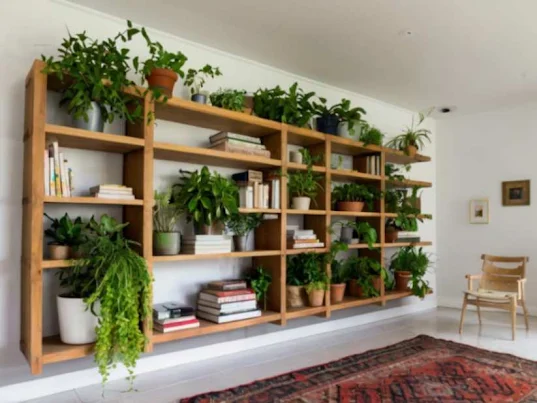Incorporating plants into bookshelves is an innovative way to enhance the aesthetics of any room while promoting a healthier living environment.
The trend of integrating greenery into home decor has gained significant popularity, and bookshelves offer a perfect platform to showcase this blend of nature and organization.
In this comprehensive guide, we will explore various techniques and tips for seamlessly incorporating plants into bookshelves, ensuring both beauty and functionality.
Benefits of Adding Plants to Bookshelves
Enhanced Aesthetics
Plants add a vibrant touch to bookshelves, breaking the monotony of books and other decorative items. The lush green foliage contrasts beautifully with the neutral tones of books and wood, creating a visually appealing display.
Improved Air Quality
Many indoor plants are known for their air-purifying properties. By incorporating these plants into your bookshelf arrangement, you can enhance the air quality in your home, reducing toxins and promoting a healthier environment.
Stress Reduction and Increased Productivity
Studies have shown that the presence of plants can reduce stress levels and increase productivity. Having greenery within your line of sight, such as on your bookshelf, can create a calming effect, making your reading or working space more pleasant.
Choosing the Right Plants
Low-Light Plants
For bookshelves that are not in direct sunlight, low-light plants are an ideal choice. Pothos, ZZ plants, and snake plants thrive in low-light conditions and require minimal maintenance.
Small and Compact Plants
Bookshelves often have limited space, making small and compact plants a perfect fit. Consider plants like succulents, air plants, and miniature ferns that do not require large pots or extensive root space.
Trailing Plants
Trailing plants can add a dynamic element to your bookshelf. Varieties such as ivy, string of pearls, and Philodendron can drape beautifully over the edges of shelves, creating a cascading green effect.
Design Ideas for Incorporating Plants
Symmetrical Arrangement
A symmetrical arrangement involves placing plants in a balanced and orderly manner. This method works well for bookshelves with uniform compartments, where plants can be evenly distributed among the shelves to create a cohesive look.
Asymmetrical Arrangement
For a more eclectic and artistic display, an asymmetrical arrangement can be used. This approach allows for a mix of plant sizes and types, creating a visually stimulating and organic feel.
Books and Plants Integration
Integrate plants directly with your books by placing small pots between stacks of books or using bookends that double as planters. This technique blends the two elements seamlessly, making the plants an integral part of the bookshelf design.
Dedicated Plant Shelf
Devote an entire shelf solely to plants. This can create a striking focal point within your bookshelf, showcasing a variety of plants in different shapes and sizes.
Tips for Maintaining Plants on Bookshelves
Proper Lighting
Ensure that your plants receive adequate light according to their needs. If natural light is insufficient, consider using grow lights to provide the necessary illumination for your plants to thrive.
Watering
Watering needs vary by plant type. Use pots with drainage holes to prevent waterlogging and root rot. Regularly check the soil moisture and water your plants as needed, taking care not to overwater.
Humidity and Air Circulation
Most indoor plants thrive in humid conditions. If your home is dry, consider using a humidifier or placing a tray of water near the plants to increase humidity. Good air circulation is also crucial to prevent mold and mildew.
Pruning and Cleaning
Regularly prune your plants to remove dead or yellowing leaves and encourage new growth. Dust the leaves periodically to keep them clean and free from pests.
Innovative Plant Displays
Hanging Planters
Utilize hanging planters to add plants above your bookshelves. This technique not only saves shelf space but also creates an interesting visual effect with plants suspended at different heights.
Wall-Mounted Planters
Wall-mounted planters can be installed adjacent to bookshelves, allowing plants to grow vertically. This adds a layer of greenery without taking up shelf space.
Terrariums
Terrariums are enclosed glass containers that house small plants, creating a self-sustaining environment. They can be placed on bookshelves to add a unique and decorative element.
Plant Stands and Risers
Use plant stands or risers to elevate plants, creating varying heights within your bookshelf arrangement. This adds depth and dimension to the display.
Seasonal Plant Rotation
Rotate plants seasonally to keep your bookshelf display fresh and interesting. This can also help in maintaining the health of your plants by giving them periods of rest and growth according to their natural cycles.
Conclusion
Incorporating plants into bookshelves is a creative way to enhance your home decor while enjoying the numerous benefits of indoor greenery. By carefully selecting the right plants, arranging them thoughtfully, and maintaining them properly, you can create a beautiful and functional bookshelf or a built-in Bookshelf that brings nature indoors.

